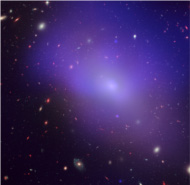Galaxies -
From The Milky Way and Beyond
galaxis.comWhat is a Galaxy?

An elliptical galaxy taken hubble
telescope with x-ray lights.
Many more different types of
galaxies can be seen in the
background.
The concept of a galaxy was first described by the Greek philosopher, Democritus. He suggested that the light band across the night sky (known as the 'Milky-Way' was actually a collection of stars.
When Galileo Galilei studied the Milky Way in 1610, he proved that it was in fact made up of a very large number of stars. In 1755, Immanuel Kant theorized that the stars we see (including our own Sun) was a collection of stars and solar systems that rotated around a central, gravitational point—it was our galaxy.
In the early twentieth century, Herber Curtis, observed several new bodies of light in space, and suggested that these were not stars at all, but that they were actually other galaxies, outside our own Milky Way.
We've been studying and finding out more about galaxies since that time.
We categorize galaxies by their shapes. The major ones identified are elliptical and spiral. Spiral galaxies are broken down into two different types:
Barred Spiral (as in the case of the Milky Way) and Unbarred Spiral (as in the case of the Sombrero Galaxy).








